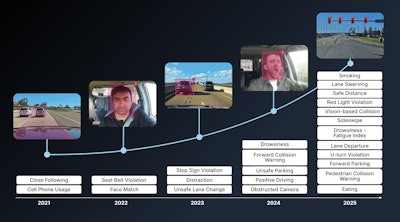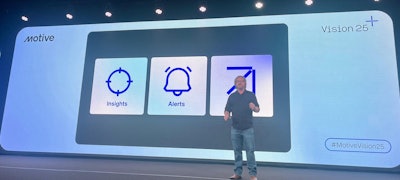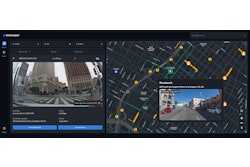
What if you could clone yourself to tackle multiple tasks at once? Now, imagine that clone is an AI version of yourself, designed to coach drivers at scale and offer personalized, targeted coaching.
According to CEO Shoaib Makani, that vision is now a reality. He introduced Motive’s AI Coach at the company’s annual summit Vision 25, hosted in Austin, Texas, on Tuesday.
The integrated operations platform’s newest innovation is the first and only AI avatar that can deliver tailored video messages to drivers, offer targeted feedback quickly, and offer coaching without increasing staff or effort.
The underlying technology to have AI that generates video and voice that sounds, looks and feels human is now possible, Makani said.
To demonstrate, Makani showed an AI-generated video of a coach giving a recap based on the driver’s weekly performance and highlighting areas that the driver did well and areas for improvement, such as safety scores, cell phone usage and vehicle idling.
The system identifies the events that have the highest impact on the driver’s score, providing drivers with clear context on what to improve and its reasoning. Besides safety, AI Coach provides feedback on fuel efficiency, compliance and more.
AI Coach is also customizable as customers can choose from pre-built avatars or create their own for a personalized touch. Currently in beta with select customers, it’s set to be rolled out across the network later this quarter.
Tim Guy, vice president of safety at RoadSafe Traffic Systems, said that within fewer than six months of combining Motive’s AI Coach with their safety program, the company has seen a 20% reduction in injuries.
The new feature aligns with Motive’s overall strategy of solving real-life challenges and embedding AI across the platform.
With a shared interface and data across its network, Abhishek Gupta, vice president of product management at Motive, told CCJ, “Our intention is not to build flashy capabilities or flashy AI models, it’s really to build AI that works.”
AI safety systems
Another innovation announced at Vision 25 was Motive’s Fatigue Index, which analyzes more than 10 indicators of driver drowsiness, including yawning, eye rubbing, reduced movement, and unusual speed fluctuations to detect fatigue early and issue alters before a potential crash occurs.
The company also unveiled its lane swerving detection feature, which identifies repeated drifting or swerving and flags it for review. The AI system analyzes repeated lane swerves over time instead of isolated alerts to give full context on the incidents, in addition to real-time alerts to notify drivers to correct behavior immediately.
It also launched an unsafe parking detection feature to give real-time alerts when a vehicle is stopped in a high-risk location, helping managers call or message drivers to prevent incidents before they happen.
[RELATED: How much public truck parking is available and how to advocate for more]
“We’re the first vendor in the industry to leverage computer vision for detecting unsafe parking, which I think is going to give us the ability to provide really accurate context-aware detection of this issue,” Gupta said.
The new solutions also leverage generative AI to stimulate and train models on real-world scenarios by using Motive’s data from its AI dashcams, enabling its AI systems to be context-aware and detect safety risks as they happen. Motive said customers that have used the AI dashcams had seen up to an 80% reduction in collisions within just one year.
Training AI to detect driver fatigue requires a colossal amount of data. Gupta explained that the company is prioritizing accuracy and minimizing false positives by ensuring an AI model is at a 95% accurate level, as well as having more than 400 people on its safety team to review videos and identify single false positives.
As an example, Gupta pointed out that the initial version of the unsafe parking detection flagged a lot of routine, low-risk parking (drivers simply pulling over on the side of the street). What really mattered, Gupta said, is parking on a highway, at night, or in remote areas, so they refined the model to focus on higher-risk scenarios.
“This sort of built a loop of data,” he said, of collecting data, identifying cases, retraining models, and redeploying to help improve accuracy, reduce false positives and deliver smarter alerts.
“Nobody ever knows where I’m at unless they track me, and that’s my safety net as someone out on the road," said Ingrid Brown, operations manager of specialized refrigerated freight at Blackjack Express. "It’s kind of like knowing that your door is locked at night."
 Motive
Motive
Makani said the company plans to release 10 more AI safety models this year.
Motive is also launching AI Assistant, which Makani said the team is working on and set to roll out later this year, and can be considered a partner that operates across the platform.
 Jadam Kahn, VP of design, MotivePamella De Leon/CCJ
Jadam Kahn, VP of design, MotivePamella De Leon/CCJ
Jadam Kahn, Motive's vice president of design, explained it can simplify day-to-day by detection of critical and timely issues while proactively recommending actions. This can be as simple as fault codes. Instead of manually reviewing faults, the assistant provides the full context of the issue, along with comprehensive code and severity descriptions. It also offers relevant actions to take, such as message the driver or mark the vehicle unsafe to drive.
It can also monitor real-time weather data, visualize the weather event and the vehicles on the map, enabling managers to send a targeted weather alert to affected drivers.
Fraud protection
Incidents of fraud are projected to continue to rise with issues such as card skimming, fuel theft and out-of-policy spend. Motive introduced a new fraud protection guarantee, offering up to $250,000 in annual coverage for customers who activate the AI-driven fraud prevention on the Motive spend management card. Unlike traditional card programs, Motive uses vehicle telematics with payment data for real-time fraud detection.
[RELATED: Motive launches new AI-powered tools to detect fraudulent transactions and reduce costs]
Caroline Barragan, head of product marketing, explained that the Motive card only be used with a mobile-based unlock feature. “When you enable this feature, cards have to be unlocked before they can be used, and if not, the transactions won’t go through," she said.
Barragan noted how a customer who had a card stolen was able to see in their Motive dashboard as the fraudster made various failed attempts to use the card at different locations. The transaction was blocked each time.
In 2024, Barragan said Motive stopped 80,000 unauthorized transactions and saved $55 million by stopping unauthorized spend.
Combining multiple data points, such as spend data, GPS locations, vehicle diagnostics and transactional rules, the AI-enabled system automatically blocks transactions when the vehicle isn’t near the fueling location, the fuel level exceeds fleet-defined limits, or a lower-cost fueling option is available nearby.
All data in one system
As businesses generate more data than ever, managing it effectively becomes a challenge. Emily Parsons, senior product manager at Motive, said that in the last 12 months alone, teams spent over 14 million hours analyzing reports within the Motive platform, highlighting the immense demand for better ways to turn data to comprehensive insights quickly.
The new analytics suite uses natural language reporting to turn questions into custom reports with easy-to-understand visuals using just a few keywords and clicks.
“Instead of searching across platforms and tools, you could get the insights you need in a single unified place. The AI takes care of the heavy work. All you have to do is start the conversation and ask a question about your data,” said Parsons.
The suite features live dashboards with pre-built views across safety, fuel usage, fleet performance, and costs, drill downs to identify causes and track trends, and offers summaries and live reports. Later this year, the company will expand these capabilities with AI-powered natural language search, allowing users to ask questions and get answers across various teams.
Other announcements included an update on the recently launched workforce management tool, which initially focused on managing drivers but now includes integrated training and qualification documents. The new integrated workforce hub consolidates all workforce insights and tasks in one place to reduce manual and disconnected systems. These include onboarding, license tracking, training, timecards and coaching, and cross-reference data to reduce likelihood of errors.













